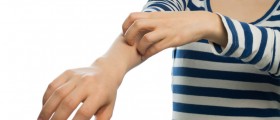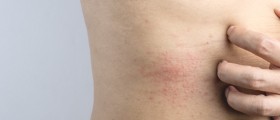
Contact dermatitis is a type of skin condition that results from direct contact with substances that are, for some reason, irritant for the skin. Those substances may be natural, for example from plants such as poison ivy and poison oak, or chemical, for example ingredients of household cleaners, soaps, solvents and such. Contact dermatitis can also be caused by jewelry items and such.
Contact dermatitis and allergens
On the other hand, contact dermatitis can result as an allergic reaction to certain substances, called allergens. Some people’s immune system reacts to allergens causing symptoms of contact dermatitis. Sometimes an allergic reaction will occur after years of exposure to allergens, but when it does develop, it will produce reactions whenever a person comes to contact with those allergens. Therefore, this skin condition can be divided onto two types- irritant and allergic.
The main symptom of contact dermatitis is rash, accompanied by mild or moderate swelling, itching, redness and pain. There may be dry and red patches of skin, usually flat, or blisters filled with clear fluid or pus. Skin rash, tenderness and itching are, in most cases, limited to the areas exposed to irritants.
Duration of contact dermatitis
Contact dermatitis is not contagious or dangerous in any way. It is, however, very unpleasant and disturbing, especially if it is a lifelong condition.
The duration of symptoms of contact dermatitis depends on a lot of factors, from the type of irritant or allergen, the duration of exposure and the amount of the substances a person has been exposed to. In most cases, though, the skin reaction resolves after several hours or days. Sometimes it may take a week or tend days for the rash to go away completely. This also depends on the type of treatment or self-care a person adopts when it comes to contact dermatitis.
The symptoms will last much shorter if some form of treatment is used. The options include over-the-counter solutions such as corticosteroids and antihistamines, or home remedies, such as cold compresses, oatmeal baths and aloe vera. It is, however, essential to avoid all further contact with the substance that caused contact dermatitis.
Future outbreaks of irritant and allergic contact dermatitis can be successfully prevented by avoiding contact with said substances. This is not always possible, which is why it is recommended to always have a topical remedy at hand, in case there is another skin reaction. Sometimes it is not easy to determine what exactly caused contact dermatitis, in which case it helps to gradually switch to other soaps, perfumes, lotions and such, to take of jewelry or to stop using latex gloves.












-Causes,-Symptoms-And-Diagnosis_f_280x120.jpg)




Your thoughts on this
Loading...